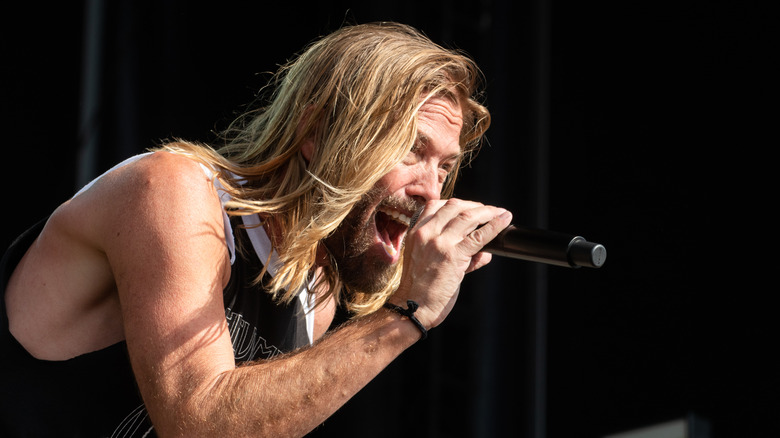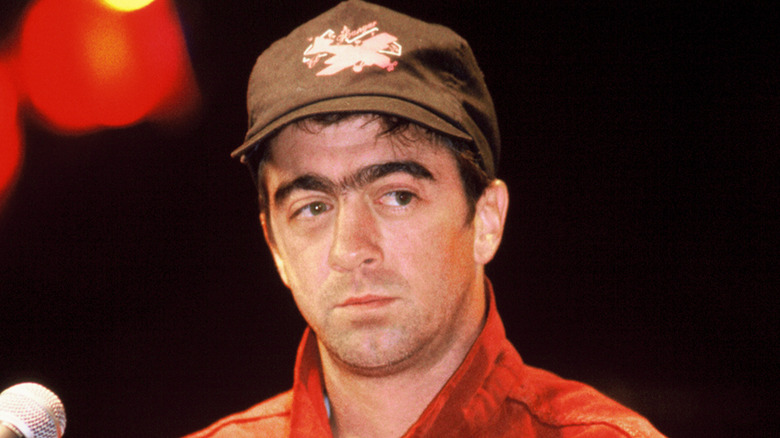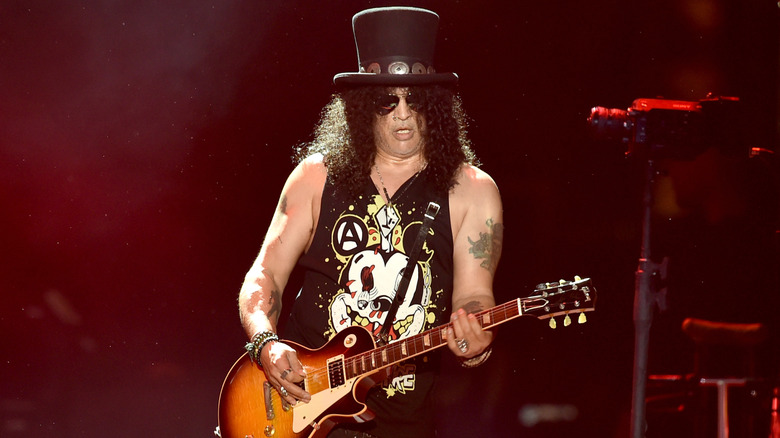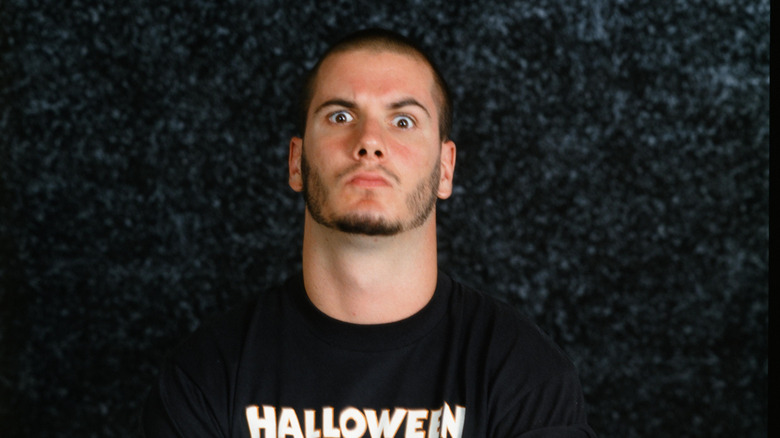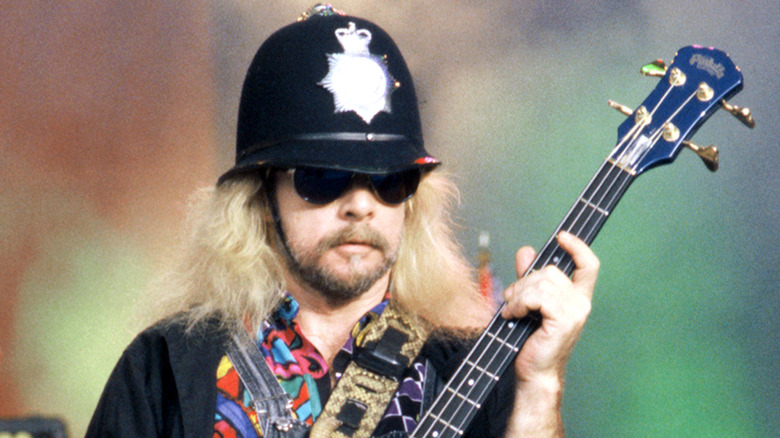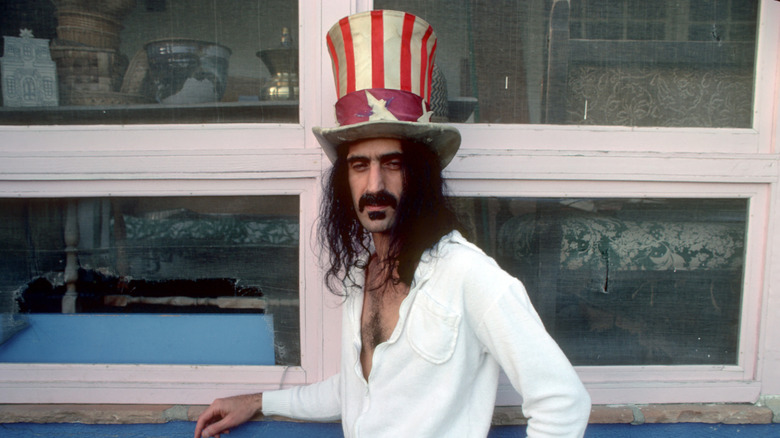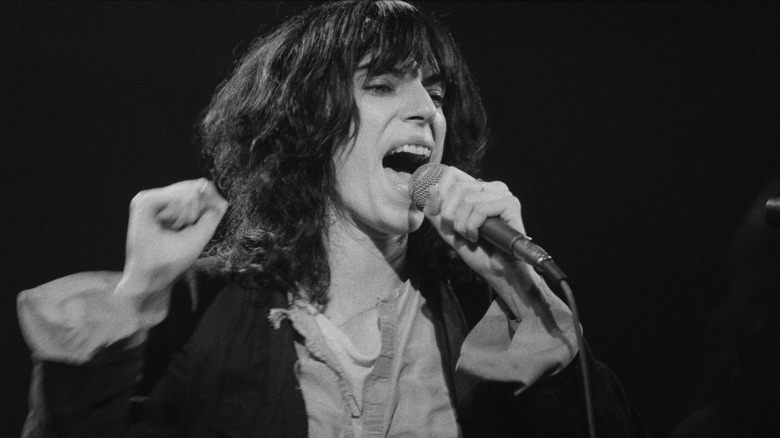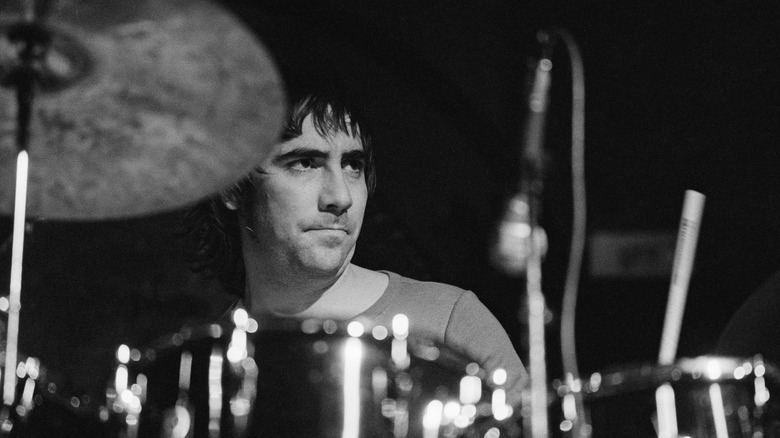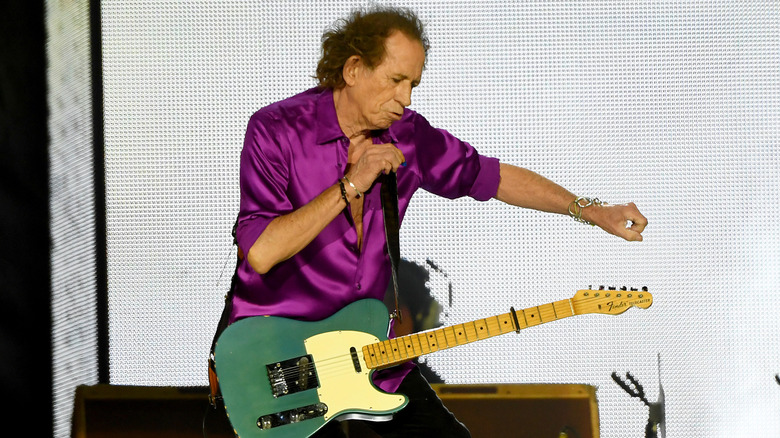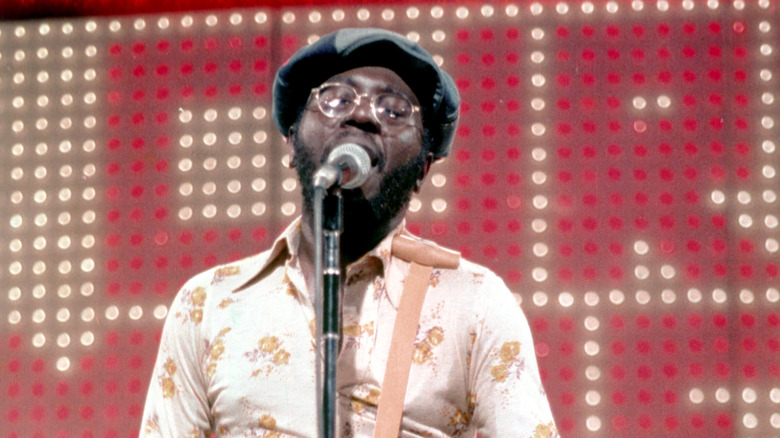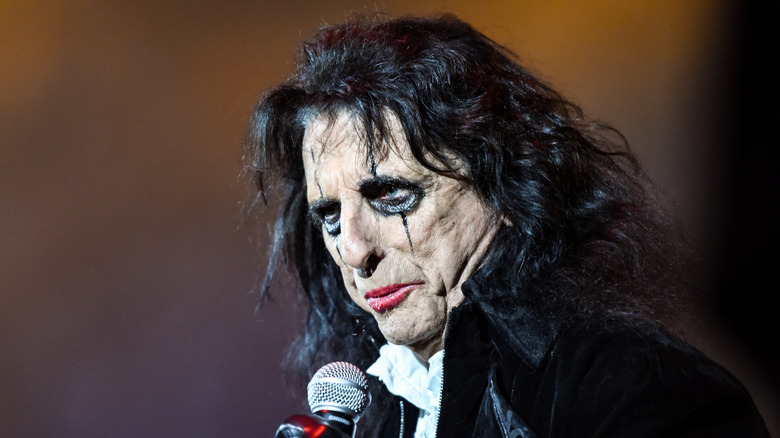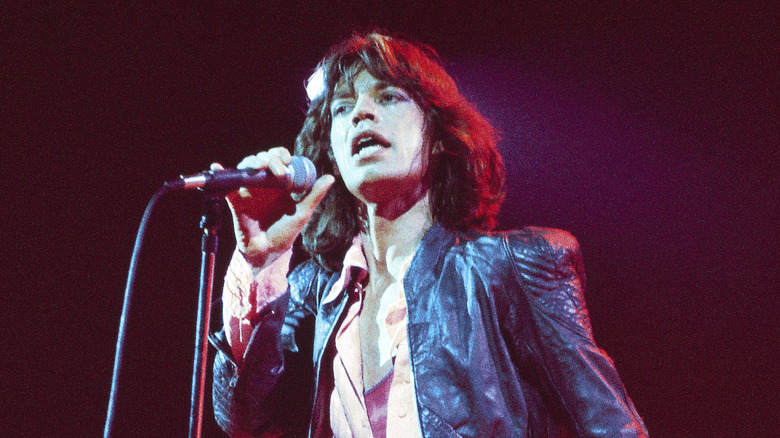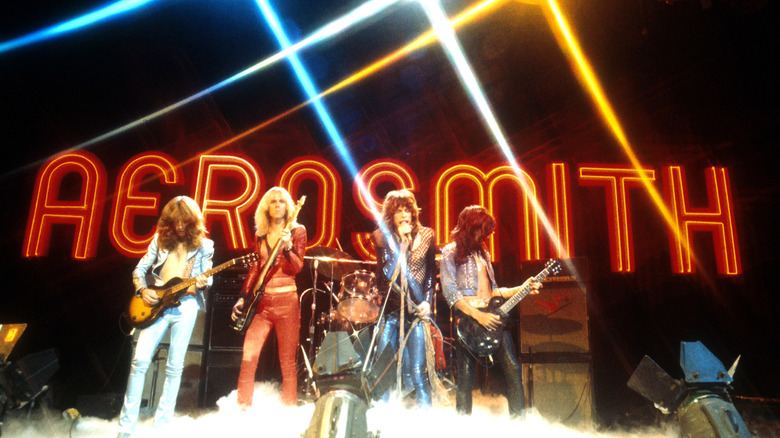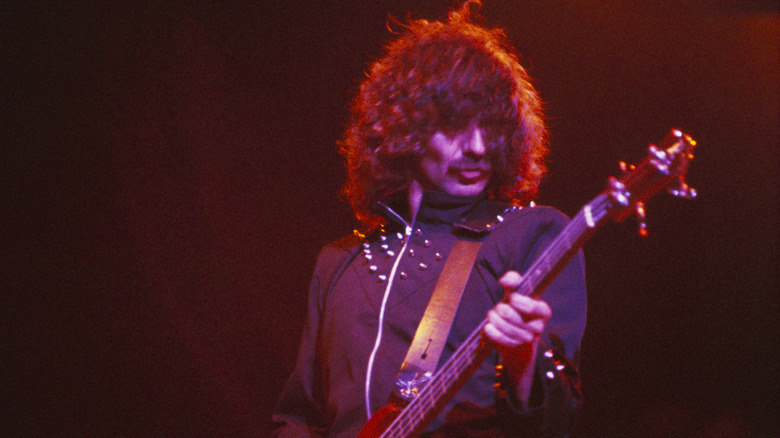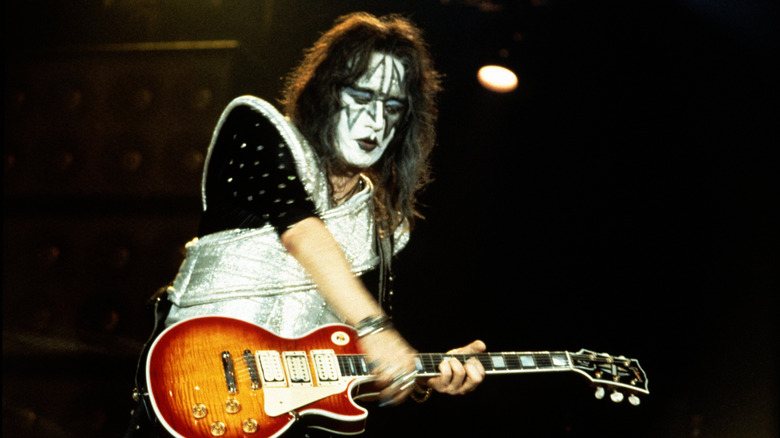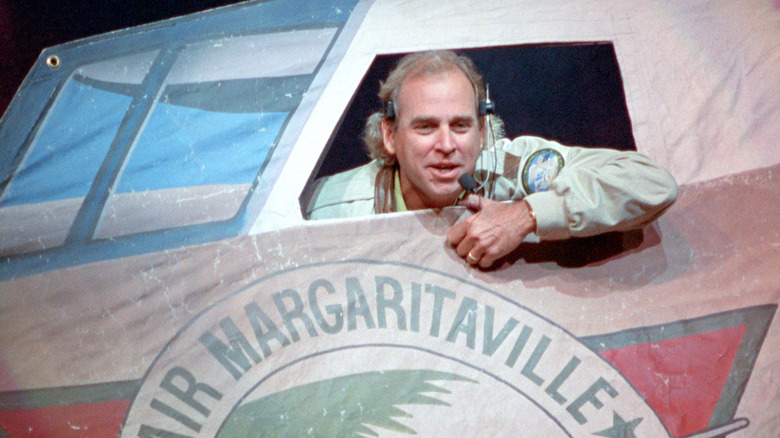Rock Stars That Nearly Died On Tour
The life of a famous rock star isn't all about writing great songs, enjoying the money, and other assorted benefits that being a well-known rocker inevitably brings. Sometimes, there's also work to be done. Take touring, for instance. Sure, it's probably amazing to play your songs to the adoring masses all over the country, or even the world. The thing is, to get from gig A to gig B to the rest of the gig alphabet means a whole bunch of rigorous traveling ... and when rockers hit the road, anything can happen.
Some bands become absolute nightmares on tour, while other bands may experience tragic accidents. Even if everything starts out smoothly and the artists behave themselves, there may be all sorts of technical malfunctions, logistical issues, and even outright risky situations. All in all, tours are a veritable buffet of disasters that range from small setbacks to a surprisingly large number of life-threatening incidents. In fact, there's a decent chance that at some point in their careers, some of your favorite rockers have almost lost their lives in strange tour mishaps. Let's take a look at the strange stories of rock stars who nearly died on tour.
The following article includes allegations and descriptions of addiction. If you or anyone you know needs help with addiction issues, help is available. Visit the Substance Abuse and Mental Health Services Administration website or contact SAMHSA's National Helpline at 1-800-662-HELP (4357).
Eric Clapton
Eric Clapton, guitarist extraordinaire and a nigh-constant presence on the rock scene since the 1960s, has overcome a tragic life to fight for the best seats in the rock 'n' roll pantheon. However, old Slowhand's musical ability and success have come with a great number of personal challenges. His appetite for drink and drugs used to be life-destroyingly copious, and it didn't make things any easier that he wasn't really facing the fact that he was an addict.
On his 1981 U.S. tour, things came to a head in a dramatic way. On March 13, 1981, Clapton had just wrapped up a show in Madison, Wisconsin, when suddenly, a brutal pain hit him. "We flew to St. Paul, Minnesota, where Roger [Forrester] had me rushed to a hospital," the musician described the situation in his self-titled autobiography (via Ultimate Classic Rock). "I was diagnosed with five bleeding ulcers; one was the size of a small orange. The doctors told Roger, who wanted to fly me back to England, that I could die at any moment since one of the ulcers was pressing on my pancreas, and could burst imminently."
Clapton ultimately avoided this grim fate and was able to return to work after a quite literally sobering stint in the hospital. Unfortunately, he soon relapsed, and didn't fully sober up until after his son's death in 1991.
David Bowie
David Bowie's career was full of art and great tunes, and even his 2016 death came with a soundtrack of sorts — his final album, "Blackstar." However, his career — and life — almost had a much earlier ending. You may have noticed that Bowie wasn't one of those artists who toured the globe well into their sixties, and there was a very good reason for that. During his "A Reality Tour" in 2004, a blocked artery gave him a serious health scare after a show in Germany, and although emergency surgery saved him, the incident caused Bowie to consider ending his career altogether.
Bowie was 57 at the time, and although he appeared as ageless and animated as ever, his band had started to notice that he wasn't all that well. He'd already begun displaying symptoms during an earlier date in the Czech Republic, but it wasn't until the June 25 gig at the Hurricane Festival when things really took a dark turn.
"We played the entire set and it seemed normal, not quite as energetic and as charged as the performance before," Bowie's guitar player, Gerry Leonard said. "We finished the show and then it seemed like David was in a lot of pain, and obviously something was wrong." Though the artist survived the ordeal and carried on his career, his touring days were done.
James Hetfield
Metallica's singer-guitarist James Hetfield has had two brushes with death on tour. The first happened on September 26, 1986, when the thrash metal giants were touring Europe, and a bad bus accident in Sweden killed their bassist, Cliff Burton. Fortunately, the other band members survived the tragedy with few injuries.
Hetfield's second close call was in 1992, when Metallica were co-headlining a Lollapalooza tour with Guns N' Roses. In Montreal, a miscommunication with a pyrotechnician led to a situation in which Hetfield was far too close to a magnesium flame when it went off. "I walk forward, I walk back, the pyro guy doesn't see me and 'whoosh' a big colored flame goes right up under me," the Metallica man described the situation (via Uproxx). "I'm burnt — all my arm, my hand completely, down to the bone. The side of my face, hair's gone. Part of my back. I watched the skin just rising, things going wrong."
Luckily, Hetfield survived his painful ordeal, and the band resumed touring a few weeks later, though it was a while before he played guitar again. To put in context just how dangerous the incident was, bassist Jason Newstead later said to People (via Far Out Magazine): "If he had been breathing in, he would have been dead."
Taylor Hawkins
From the outside, it might have seemed like The Foo Fighters' Taylor Hawkins led a pretty charmed rock star life. Playing drums in one of the biggest bands in the world and having the notoriously nice Dave Grohl as a bandmate; what's not to like? The problem is that, at one point, Hawkins liked it all a little too much.
In 2001, Hawkins was hospitalized, and the Foo Fighters called it quits on the final four concerts of their European tour. It eventually came to light that the drummer had overdosed on heroin so severely that he spent two weeks in a coma.
Hawkins somewhat downplayed the life-threatening incident itself, saying that he merely liked to party a bit too hard, referred to his time in a coma as a "happy nap," and seemed to express more concern at whether the Foo Fighters would survive that hurdle or not. However, that's not to say Hawkins didn't take the admittedly pretty drastic wake-up call to heart. "There was a year where the partying just got a little too heavy," the drummer told Beats 1 (via Ultimate Classic Rock) in 2018. "And thank God, on some level this guy gave me the wrong line or the wrong thing one night, and I woke up going, 'What the f*** happened?' That was a real changing point for me."
Bill Berry
In 1995, alt-rock superstars R.E.M. were touring the globe in support of their "Monster" album, but the tour turned out to be a dangerous experience for several band members. Bassist Mike Mills had a tumor scare, and singer Michael Stipe had to have surgery for his hernia, but the first and worst of the tour's health troubles came for drummer Bill Berry, who almost died of a brain aneurysm.
A March show in Lausanne, Switzerland, proved difficult for Berry, who started to feel a nasty pain in his head and eventually had to leave the stage when it pretty much knocked him out. "It felt like a bowling ball hit me in the head," the drummer described the experience to the Los Angeles Times (via Diffuser). "There wasn't any warning. I was just singing the falsetto part on 'Tongue' when it happened."
Berry's condition turned out to be not just one but two brain aneurysms — one of which had already ruptured. Fortunately, the daunting situation had a happy ending. Berry was rushed to a thankfully successful surgery, and R.E.M. was able to resume touring in May. Still, although the drummer reportedly made a full recovery, the experience might have caused him to reevaluate his life in some ways. After all, Berry left the band on good terms in 1997, saying (via Rolling Stone) that his "priorities [had] shifted."
Slash
Guns N' Roses are pretty much the poster boys for rock 'n' roll excess, but even then, guitarist Slash's close call in a San Francisco hotel during one tour in 1992 is almost too strange to believe. As Slash has since admitted, drugs were, perhaps predictably, involved. Less predictably, he says that this particular overdose actually killed him.
The musician's heart allegedly stopped for no less than eight minutes until paramedics were able to revive him. One might expect that temporarily dying in the middle of a tour would be a pretty daunting experience, but as Slash tells the tale, being dead for a considerable period of time didn't faze him all that much. "They took me to the hospital but I said, 'I'm fine', signed myself out, went back to the hotel and we flew to the next gig," the guitarist described the surprisingly chill aftermath of the incident to The Guardian.
Phil Anselmo
Phil Anselmo has led a pretty controversial and eventful life, from his tragic early years to more recent accusations of racism. Even — or, perhaps, especially — his heyday as the front man of groove metal titans Pantera had no shortage of dramatic events. Notably, Anselmo almost died of a heroin overdose in 1996, during the band's "The Great Southern Trendkill" tour.
According to Anselmo, his heroin use was a natural extension from the various painkillers he'd used to manage a serious and painful back condition called degenerative disc disease. The rest of the band was reportedly unaware that the singer had turned to the drug, so when he overdosed after a Dallas show, the effects on the members' already strained relationship were quite severe ... but not as severe as they nearly were to Anselmo's life. Per Loudwire, the singer's own eventual statement about the incident made it clear just how close he'd been to death's door: "I, Philip H. Anselmo, immediately after a very successful show in Dallas injected a lethal dose of heroin into my arm, and died for four to five minutes," it started, before issuing a number of promises about keeping the tour going and himself in the land of the living.
Leon Wilkeson
Bassist Leon Wilkeson might just be the patron saint of rockers with near-death tour experiences. He was a survivor of one of the most famous tour travel tragedies in the history of rock music. Wilkeson plied his trade in a little band called Lynyrd Skynyrd, and he was among the passengers when the infamous plane crash on October 20, 1977, abruptly ended their "Street Survivors" tour — as well as the band itself, until its reformation later down the line.
Three band members and three others died when their plane ran out of fuel and crashed near Gillsburg, Mississippi. Twenty other people survived, but their injuries were grim and plentiful, and Wilkeson's were quite possibly the worst of the bunch. He broke an arm and a leg, his teeth were a mess, and his internal injuries were so numerous that his heart stopped not just once but twice during surgery.
Wilkeson survived his ordeal, but another awaited in the early 1990s, when the era's incarnation of Lynyrd Skynyrd was touring and someone slit his throat while he was asleep in the tour bus. The culprit remains a mystery, though reportedly, Skynyrd guitarist Ed King and Wilkeson's wife have blamed each other for the incident. As for Wilkeson, he survived the strange incident and didn't even bother to press charges.
Frank Zappa
December 1971 was bad for Frank Zappa. On December 4, the artist and his Mothers of Invention band inadvertently inspired Deep Purple's hit song "Smoke on the Water" when a fan decided to whip out a flare gun during their show at the Montreaux Casino in Geneva, Switzerland. The ensuing fire soon became a dangerous, smoking inferno that burned the building down. Fortunately, there were no casualties or even serious injuries, thanks in part to the heroics of concert organizer Claude Nobs and, reportedly, Zappa himself, who smashed a window with his guitar to help people escape.
The second time Zappa's life was in danger that month came only six days later, on December 10. While the band was playing the Rainbow Theatre in London, a fan rushed the stage — reportedly in a fit of jealousy over his girlfriend's Zappa infatuation — and pushed the artist off the stage. Zappa's fall into the orchestra pit crushed his larynx and gave him chronic back pain, along with an assortment of grievous injuries.
"The band thought I was dead," he wrote in "The Real Frank Zappa Book" (via Ultimate Classic Rock). "My head was over on my shoulder, and my neck was bent like it was broken. I had a gash in my chin, a hole in the back of my head, a broken rib, and a fractured leg. One arm was paralyzed." Zappa ended up spending a year in a wheelchair.
Jonathan Davis
Headbanging onstage might be a fairly significant part of Korn vocalist Jonathan Davis' job description, but in 2006, a strange blood condition turned this routine metal behavior into a potential death trap. Several of the band's tour dates in Europe that year went down the drain when Davis started to notice strange marks on his skin that left his body looking literally beat up. "We had just done a show in Hamburg, Germany," the singer described to Billboard. "I was on the bus and noticed all this bruising all over my body. It wasn't bad, just here and there, but I was like, what the hell? This ain't right. I don't remember hitting myself or anything, and I never bruise."
The bruises eventually turned out to be a full-on blood infection, brought on by a blood disorder called immune thrombocytopenic purpura, or ITP for short. The condition may kick in when your blood platelets are low enough, and it stops the blood from clotting normally, causing internal bleeding and bruising, as well as potential hemorrhages (hence the risk that the headbanging would have presented). Davis' ITP reportedly stemmed from an allergic reaction and was nearly fatal. Fortunately, he consulted his doctor and got to a hospital in time.
Patti Smith
The year was 1977, and poet-turned-punk rock trailblazer Patti Smith's band was touring as a support act for a far more traditional rocker, Bob Seger. This tour had drastic and longstanding consequences for Smith. During a concert in Tampa, Florida, the punk poet fell off the stage and suffered horrific spinal injuries. The broken neck vertebrae and fractured spine from her fall into the orchestra pit sidelined her for a long time, and recovery required a large amount of physical therapy and a lengthy stint with a neck brace.
The accident reportedly happened when Smith spun on the stage and lost her footing. Though she and her career ultimately recovered, in 2012, Smith told Uncut (via NME) that her back was still bothering her and that she felt Seger's crew was to blame. "I was being careful on the stage because there wasn't as much room or light. I didn't whirl around as much as usual, but when I hit the monitor with my foot, it was half hanging over the lip of the stage," she explained. "We needed more space and light, and we didn't get it, and I had an accident."
Keith Moon
The Who's buck-wild drummer Keith Moon died after an accidental overdose in 1978, at only 32 years old. However, that was far from his first overdose. On November 20, 1973, The Who played the first show of their U.S. tour in San Francisco. At least, The Who started the show; three-quarters of The Who and a crowd member named Scott Halpin ended up finishing it, on account of Moon having taken a pretty big helping of PCP to calm his nerves before taking the stage.
It soon became evident that the drummer was having an extremely bad day, and when the friend Moon had taken drugs with had to be rushed to the hospital, the severity of the situation became evident. The fact that Moon stopped playing and passed out partway through "Won't Get Fooled Again" probably also helped.
Unfortunately, Halpin wasn't around to rescue the band on March 9, 1976, when Moon was once again unable to play a gig, this time at the Boston Garden. The concert had to be stopped and rescheduled, and although Moon's situation was initially explained away as a debilitating case of flu, it was ultimately revealed that the reason behind the drummer's condition was "a near-lethal intake of brandy and barbiturates."
Keith Richards
Keith Richards is so notorious for cheating death that there's a somewhat well-known saying that he and cockroaches would be the only living things to survive a nuclear war – and there's an actual cockroach species named after him. The Rolling Stones guitarist had one of his earlier near-death experiences way back in 1965, when the Stones were bringing their music Stateside. A December 3 concert in Sacramento, California, was business as usual, right up until the point when the guitarist's instrument connected with a microphone stand.
A large number of sparks and one stunned guitarist flew as a surge of electricity knocked Richards out in the most dramatic way possible. The mic stand had been ungrounded, and the ensuing electrical shock nearly killed Richards. "I saw the blue light. I literally saw Keith fly into the air backward," audience member Mick Martin described the events to The Huffington Post. "I thought he was dead. I was horrified. We all were. Silence fell over the crowd."
Fortunately, Richards had been wearing a pair of rubber-soled boots that day, which may have been instrumental in saving his life. In a textbook example of his tendency to survive seemingly fatal scenarios, he woke up in an emergency room and was back onstage the very next day.
Thom Yorke
In 1993, Radiohead was a very different band from the experimental outfit of today. Riding high on the wave of their first, grunge-influenced album, "Pablo Honey," they spent the summer of that year touring the U.S., and on Independence Day performed for the "MTV Beach House" show. That particular Fourth of July nearly ended in some pretty tragic fireworks, thanks to front man Thom Yorke's dip in a nearby swimming pool.
As the band performed the song "Anyone Can Play Guitar," Yorke gave a wild, screaming performance that culminated when he decided to leave the stage by diving headfirst in a pool ... and then, reportedly, climbed up from the other side of the pool and tried to grab a live microphone while soaking wet. Fortunately, someone had the presence of mind to quickly take the mic out of the dripping singer's reach.
The incident doesn't show in the aired footage, in which you just briefly see Yorke urgently conferring with a crew member after climbing out of the water — but if the report is true, one can only thank whoever kicked that microphone away.
Travis Barker
Sometimes, even a quick mini-tour of just one free concert in another state can prove dangerous, and few know this better than Travis Barker of Blink-182 fame. In September 2008, the duo project of Barker and his friend Adam "DJ AM" Goldstein, TRVSDJ-AM, performed in Columbia, South Carolina. Afterward, they were set to fly back to California, but unfortunately, their Learjet's takeoff ended in a bad crash that killed four people on board. Only the two musicians survived.
Barker's injuries were truly grievous. He was in critical condition, with over 65 percent of his body badly burned. "The plane's on fire and my hands are on fire so I unbuckle my seat belt and I jump right into the jet, which holds all the fuel. I basically ignite my whole body in fire," he described the incident to ABC News in 2015. "I'm so soaked in jet fuel, there's nothing I can do to put the fire out."
The drummer's road to recovery included 27 surgeries and was so arduous that at one point, he openly offered $1 million to any friend who would be willing to end his pain. Barker eventually recovered, but he has rather understandably avoided planes ever since.
If you or someone you know is struggling or in crisis, help is available. Call or text 988 or chat 988lifeline.org
Charlie Puth
Charlie Puth's musical output may not be quite as heavy as some of the other folks on this list, but then again, the man has a history of working with the likes of Ozzy Osbourne and Slash. Besides, Puth's touring schedule alone seems to be far more metal than most, considering that it has reportedly almost killed him twice.
Puth got his start as a YouTube star in 2009, and eventually hit the mainstream both as a singer-songwriter in his own right and as a songwriter for other artists. Add touring on top of his assorted endeavors, and apparently, things haven't always been all that smooth. "I used to get sick a lot on tour," Puth said to "Lorraine" (via E!News) in 2019. "I almost died twice, like literally. It was really tough. I kept getting sick. I was sick for like a year with a cold and I just wasn't really taking care of myself."
Puth didn't go into specifics about precisely what kind of health scares his two close calls entailed, but he did say that he eventually came to understand how one can live the touring life without repeating health emergencies. "Now, I know how to tour," he said. "I figured it out. It took four years, but."
Curtis Mayfield
Getting his start with vocal group The Impressions, soul singer Curtis Mayfield rocketed to stardom in the early 1970s with such hits as "Move On Up" and his soundtrack to "Superfly." By 1990, however, Mayfield's career had stalled. Sales of his new records were weak, and he paid the bills by going on tour to perform his hits for fans.
That year, he had just taken to the stage at an outdoor show in Brooklyn when a massive gust of wind sent equipment toppling. That included a lighting truss, sending a large stage light plunging like a rock. Struck in the back of the neck, Mayfield crumpled to the ground and then realized he couldn't move. He was rushed to a hospital, where doctors delivered the grim prognosis: the light had smashed several vertebrae in his spine, leaving him paralyzed from the neck down.
A few years after the accident, Mayfield recalled that horrific moment during an interview with music journalist Richard Williams. "It happened, and it happened fast. I never even saw it coming," Mayfield said, noting that he couldn't even remember falling. The first moment he could recall after the accident was regaining consciousness while lying on the stage. "And then I discovered that neither my hands nor my arms were where I thought they were, and I couldn't move," he added. Mayfield's tragic life ended in 1999 at age 57.
Otto Schimmelpenninck van der Oije
Dutch metal band Delain was touring the U.K. in 2014 when bassist Otto Schimmelpenninck van der Oije exited the concert in severe medical distress. During the show, he was so focused on playing that he didn't realize he'd placed himself in the line of fire when a streamer cannon (essentially a confetti cannon that shoots metallic streamers) fired into the audience. "As they have to shoot up to 12 meters, they're quite powerful," he explained in an interview with Vice.
The projectile struck him below the belt, at close range. He recalled feeling immediate pain, which worsened as the concert continued. "The pain was pretty bad at first, but not alarming, but pretty soon it got to a level where it was really, really bad," he recalled. "So bad, in fact, I was afraid I would lose consciousness." Despite the increasing severity of the pain he was experiencing, the musician managed to make it to the end of the show.
"After the show the damage was more obvious: my scrotum was the size of a big grapefruit and I was in a lot (yeah, really a lot) of pain," he wrote in a message he shared via Facebook. Surgery was required, with doctors discovering that one of his testicles had ruptured. "I was very close to losing my left testicle, but chances are good it will be fine," he continued.
Nick Lowe
Prior to his success as a solo artist, Nick Lowe was front man of a band called Brinsley Schwarz. A 1969 London gig, however, was nearly his last when he was accidentally electrocuted onstage. He was hit with so much voltage that he actually died. Lowe was subsequently revived and miraculously lived to tell the tale.
In a joint interview with Deadline about their book, "The Show Won't Go On: The Most Shocking, Bizarre, and Historic Deaths of Performers Onstage," authors Jeff Abraham and Burt Kearns explained that while researching the book, they'd learned about Lowe's death and resurrection. According to the two, Lowe gripped a malfunctioning microphone that sent a powerful jolt of electricity coursing through his body. "He was unable to let go. His heart stopped. He was revived when his keyboard player attempted to kick the mic out of his hands — but, instead, gave him a boot square in the chest!"
That kick to the chest, accidental though it may have been, wound up saving Lowe's life, restarting his heart and literally bringing him back from the dead. Without that kick, music fans would never have been able to enjoy his subsequent hits, including the likes of "Cruel to Be Kind," "Cracking Up," and "I Knew the Bride (When She Used to Rock 'n' Roll)."
Tom Petty
In 1985, Tom Petty and the Heartbreakers hit the road to tour with legendary singer-songwriter Bob Dylan. During a break in the tour, Petty returned to California to spend time with his family at their home. Unbeknownst to Petty, however, an unknown person with an apparent axe to grind snuck into the house, doused an area with lighter fluid, and lit it up in an apparent attempt to murder him. Petty, his wife, and their 5-year-old daughter were able to escape the fire, which burned down the entire house and left only Petty's basement recording studio intact. "The whole place, just like a matchbox, it went up really fast," Petty told Paul Zollo for his book, "Conversations with Tom Petty."
Realizing someone had a vendetta against him, when Petty returned to the road, he took his wife and kid with him for safekeeping. Subsequent investigation confirmed that the fire was indeed the result of arson. "To have somebody try to kill you is a really bad feeling," Petty added. "They didn't just try to kill me, they tried to wipe out my whole family."
The trauma, in fact, lingered with the Pettys long afterward. "We were shaken for years by it," Petty admitted. "It really took a long time. And it was 10 times as bad, because you knew that somebody just went and did it. Somebody tried to off you."
Alice Cooper
Shock-rock pioneer Alice Cooper's theatrical stage shows featured such horror-movie elements as a live boa constrictor, faux guillotine decapitations, and an elaborate stunt in which he was seemingly hanged on a gallows. That particular illusion was created via stage magic trickery, but there was one time when the contraption malfunctioned and the "School's Out" singer was nearly hanged for real.
Magician and debunker of fake psychics James Randi (aka the Amazing Randi) created the illusion, in which Cooper was covertly attached to a harness that hung from the rafters by piano wire. By the time Cooper performed the stunt at Wembley Stadium in 1988, he'd done it so many times that it was second nature.
"Everything has its stress limit and after doing so many shows, I never thought about changing the wire. You know, I figured it'll last forever," Cooper explained in a 2018 interview with Entertainment Weekly. That night in London, however, the wire frayed and snapped. "I could hear the rope hit my chin and in an instant I flipped my head back," he recalled. Luckily, the rope didn't catch his chin, which would have broken his neck. "That must've been a fraction of a second because if it caught my chin it would have been a different result," Cooper said. "It went over my neck and gave me a pretty good burn. I went down to the floor and pretty much blacked out."
Mick Jagger
The Rolling Stones' free music festival at the Altamont Speedway in 1969 turned deadly when the band — on the advice of The Grateful Dead's manager, Sam Cutler, who'd been enlisted to handle its U.S. tour — brought in the Hells Angels to provide security. The bikers' menacing presence came to a head when one of the Angels murdered Black teenager Meredith Hunter near the front of the stage, and front man Mick Jagger's life also became imperiled after the performance.
When the Stones reportedly refused to pay the Angels their $50,000 fee, chapter president Ralph "Sonny" Barger took action. Interviewed for the A&E series "Secrets of the Hells Angels" (via People), Hells Angel Charles "Peewee" Goldsmith claimed Barger began circulating the message that "he wants to whack Mick Jagger." That led to years of failed assassination attempts, including one — circa 1979 or 1980 — in which a small rubber pontoon loaded with explosives was positioned near Jagger's yacht while docked at Martha's Vineyard. That plot, however, went south when the pontoon sank.
Back in 1983, UPI reported an Angel identified only as "Butch" who'd testified to the Senate Judiciary Committee, confirming that there was "more or less an open contract" on Jagger. The Angels eventually received their $50K, and the hit was called off.
Steven Tyler
During a 1977 tour, Aerosmith took to the stage in Philadelphia. The crowd was characteristically rowdy, evident when one of the concertgoers hurled an M-80 — a powerful firecracker — on the stage just as the band returned for the encore. "I was going up the stairs right behind [front man] Steven [Tyler] and [guitarist] Joe [Perry], and I felt the concussion of the cherry bomb going off," guitarist Brad Whitford recalled in an interview with Goldmine (via Ultimate Classic Rock). "Steven immediately covered his face and there was blood shooting up out of Joe's arm, literally. So pretty quickly we got ourselves to the emergency room." Tyler's eye was damaged when his cornea was burned, but it could have been a lot worse had Tyler been closer to the firecracker when it exploded.
That wasn't the only time that a Philly show took a perilous turn for the singer. The following year, the band was about 20 minutes into its set when somebody in the audience threw a glass bottle onto the stage. "It hit the stage dead center, right in front of the monitor, and exploded, sending shards of glass into Steven's face," said Whitford when recounting the event in the band's memoir, "Walk This Way." "I think some glass went right through his mouth."
Geezer Butler
While it's not uncommon for modern-day music stars to bring their own private chefs on tour with them, that wasn't the case for Black Sabbath bassist Geezer Butler. A committed vegan, Butler was touring as a solo artist in 1995 when he somehow managed to eat something that didn't agree with him. "I got this food poisoning and it got so bad I nearly died," Butler recalled in a 2020 interview with Kerrang.
Despite feeling ill, Butler was a firm believer in that old adage about how the show must go on. With a concert to give and an audience awaiting him, he figured he'd push through the discomfort and play the gig. It did not go well, quickly escalating from bad to worse. "I was leaning up against the amps and I think people just thought I was pissed off playing there," said Butler, who revealed that he found himself hallucinating until one of his bandmates pulled the plug and called an ambulance.
Butler was rushed to intensive care; by the time he was released, he received even more bad news. "By the time I recovered, the tour had been scrapped so that was that," he said.
Ace Frehley
Back in their 1970s heyday, KISS shows were notorious for their high-octane pyrotechnics. That was epitomized by Ace Frehley's special guitar, which had been customized to fire smoke bombs as projectiles. As one might expect, a rocket-launching musical instrument wasn't always the most accurate, and there were a few times when a smoke bomb nearly hit bassist Gene Simmons — just one part of the messed-up reality of KISS. Another time, one of them wound up severely burning Frehley's leg. "A smoke bomb ignited too early inside the cavity of the guitar, and it melted the asbestos — which our f***ing costumes were made from — to my thigh," the guitarist told Music Radar.
While that was a close call, Frehley nearly felt the icy grip of the Grim Reaper during a 1976 concert in Lakeland, Florida, when an improperly grounded cable electrified a metal railing on a staircase. When Frehley touched the rail, he was electrocuted. "I should have been dead that night," Frehley recalled, marvelling that the shock sent him careening backwards — even though he was strapped to a heavy Les Paul guitar. "If I fell forward, I would have broken my f***ing neck," he recalled. "But I fell back, and the road crew dragged me back off of the staircase. I had no feeling in my hands for five to 10 minutes." Not only did Frehley survive, he returned to the stage and finished the concert.
David Bryan
Touring the globe with a rock band is undoubtedly an amazing way to see the world, visiting exotic locales while performing in jam-packed stadiums full of adoring fans. There are, of course, downsides, which Bon Jovi keyboardist David Bryan can certainly confirm. Interviewed by Keyboard magazine, Bryan recounted the time he was on tour with the band and wound up becoming severely sick. "I got parasites in South America, and it almost killed me," he said. In fact, he explained, he became so ill that he was unable to play keyboards at all, and was forced to take a lengthy hiatus from the band.
He wound up hospitalized for two weeks, and the experience took a lot out of him; according to Bryan, he wound up losing a staggering 40 lbs. "They ate out my intestines and my stomach, and put me out of commission for about six months," he continued. Ultimately, it took Bryan a full two years to fully recover to the point where he felt he was able to play as well as he had before.
Michael Clifford
During a 2015 concert at London's Wembley Stadium, Australian rockers 5 Seconds of Summer experienced a harrowing moment when some onstage pyrotechnics went awry. When the flash fired, guitarist/singer Michael Clifford's hair was set ablaze. The fire was quickly extinguished, but not before Clifford suffered burns on his head that were severe enough that the concert had to be halted. "Michael has hurt himself so we will not be continuing the show right now," his bandmate, Ashton Irwin, told the crowd (via Billboard). "He is okay. You guys have been the best crowd we could ask for tonight. Thank you so much."
Clifford later took to social media to update fans on his condition, tweeting a photo of himself offering a thumbs up while displaying heavy bandages covering half his head. "sorry I couldnt finish the encore, but at least I look like two face," he said, referencing the Batman villain who was burned and disfigured on one half of his face.
While catching fire could have had a fatal outcome, Clifford luckily recuperated quickly. "Michael is recovering well after being given the all clear by doctors," read a statement issued to Billboard by a band spokesperson, revealing that Clifford was well enough to perform, just one day after his injury. The statement, however, also indicated there would be an abundance of caution. "There will be no pyrotechnic production for the show this evening," the spokesperson added.
Jimmy Buffett
Jimmy Buffett nearly bought the farm in an incident that not only would have been right at home in one of his songs, but actually inspired one. Back in 1996, Buffett was in the midst of a Caribbean tour in celebration of his 50th birthday, flying from gig to gig in a 1955 Grumman HU-16B Albatross, known as a flying boat for its ability to land on both airstrips and water (Buffett bought it in 1990, and then fully restored it).
When the plane arrived in Negril, Jamaica, Buffett's plane was carrying some VIP passengers: U2 front man Bono, his wife and kids, and Island Records founder Chris Blackwell. Unbeknownst to Buffett, Jamaican police had mistakenly identified the plane as one used for drug smuggling and began shooting at it. "These boys were shooting all over the place," Bono said when recounting the incident, via Buffett's Margaritaville website. "I felt as if we were in the middle of a James Bond movie ... I honestly thought we were all going to die ... You can't believe the relief I felt when I saw the kids were okay."
The whole thing may have been harrowing, but wound up being put to music in a song, "Jamaica Mistaica." "Like all things, it made for a good song," Buffett told The Spokesman-Review in 1996.




